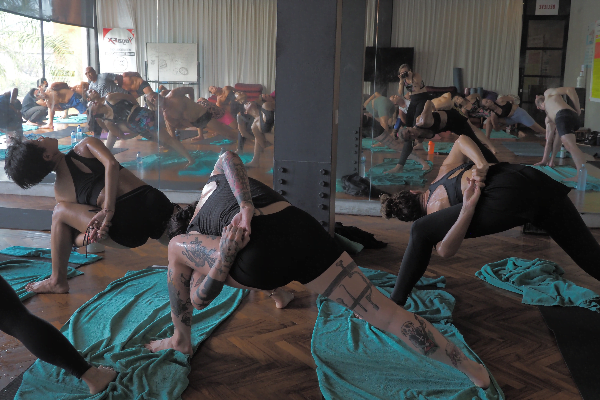In the vast realm of yoga, there are numerous styles and practices, each with its own unique attributes and benefits. Among these, hot yoga stands out as a dynamic and intense form of practice performed in a heated room. Hot yoga, also known as Bikram yoga or 26 and 2 yoga, offers a distinct experience that sets it apart from regular yoga. In this article, we will explore the exceptional benefits of hot yoga versus regular yoga, shedding light on how the element of heat can transform our practice, enhance flexibility, deepen mindfulness, promote detoxification, and boost physical fitness.

Benefits of Hot Yoga
1. Enhanced Flexibility and Range of Motion
Hot yoga, practiced in a heated room typically set between 95-105 degrees Fahrenheit (35-40 degrees Celsius), creates an environment that encourages deep stretching and increased flexibility. The heat warms the muscles, making them more pliable and allowing for greater range of motion. Through consistent practice, hot yoga helps to lengthen and strengthen muscles, improve joint mobility, and enhance overall flexibility. This increased flexibility is beneficial for both everyday activities and more advanced yoga poses.
2. Intensified Physical Workout and Calorie Burn
Hot yoga provides a challenging and vigorous physical workout. The combination of heat and the specific sequence of poses in hot yoga classes, such as the 26 and 2 series, elevates the heart rate, increases blood circulation, and engages various muscle groups. The intensified workout leads to an elevated calorie burn, helping with weight management and promoting overall physical fitness. Hot yoga sessions can be considered a comprehensive full-body workout that targets strength, endurance, balance, and cardiovascular fitness.
“Don’t Live Without Trying”
3. Deepened Mindfulness and Mental Focus
The demanding nature of hot yoga, combined with the heat, requires focused attention and cultivates mindfulness. The active engagement with challenging poses in a heated environment compels practitioners to be fully present and attuned to their breath and body. This deepened state of mindfulness promotes mental clarity, concentration, and a sense of inner calm. Hot yoga becomes a moving meditation, allowing individuals to temporarily escape from external distractions and connect with their inner selves.
4. Promoted Detoxification and Cleansing
The heat in hot yoga classes induces sweating, which supports detoxification and cleansing of the body. Sweating helps to release toxins, impurities, and excess fluids from the system, leaving practitioners with a refreshed and rejuvenated feeling. The heat also increases blood circulation, aiding in the removal of waste products and delivering oxygen and nutrients to the cells. The combination of physical movement, breathwork, and heat in hot yoga creates an internal cleansing effect, promoting overall well-being.

Benefits of Regular Yoga
1. Holistic Mind-Body Connection
Regular yoga practices, such as Hatha, Vinyasa, or Ashtanga, emphasize the integration of breath, movement, and mindfulness. Through the consistent practice of regular yoga, individuals develop a deep mind-body connection. The focus on breath awareness and conscious movement cultivates a sense of unity between the body and mind, enhancing overall well-being and promoting self-awareness.
2. Adaptability and Accessibility
Regular yoga offers a diverse range of practices and classes that cater to individuals of all fitness levels and abilities. Whether you’re a beginner or an advanced practitioner, there are options available to suit your needs. Regular yoga classes often provide modifications and variations of poses, making it accessible to everyone. This inclusivity allows individuals to experience the benefits of yoga regardless of their physical condition or limitations.
3. Relaxation and Stress Relief
Regular yoga practices incorporate relaxation techniques, such as Savasana (Corpse Pose) and meditation, which promote deep relaxation and stress relief. Through conscious breathing, gentle
movement, and guided relaxation, regular yoga classes help individuals unwind, release tension, and find inner peace. This relaxation response supports the reduction of stress hormones, improves overall mental well-being, and enhances the body’s ability to rest and rejuvenate.
Conclusion
In the realm of yoga, both hot yoga and regular yoga offer unique benefits that cater to diverse needs and preferences. Hot yoga stands out with its emphasis on increased flexibility, intensified physical workout, deepened mindfulness, and detoxification. On the other hand, regular yoga provides a holistic approach, promoting mind-body connection, adaptability, and relaxation.
To deepen your understanding and practice of yoga, consider exploring the YogaFX International Yoga Teacher Training Academy. Upon completion of the Course in YogaFX, you will graduate with three international yoga teacher certifications, equipping you with the knowledge and skills to share the transformative power of yoga with others. The journey of yoga is vast and ever-evolving, and by embracing both hot yoga and regular yoga, you can unlock a wealth of benefits for your physical, mental, and spiritual well-being.





